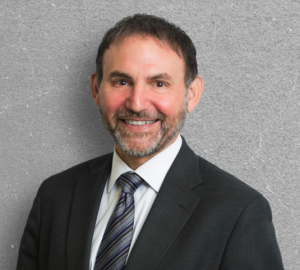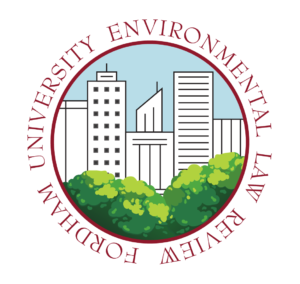Meet Michael Bogin: Principal at Sive Paget & Riesel

by Loren Naftali, Associate Editor, Fordham Environmental Law Review
Michael Bogin, principal at Sive Paget & Riesel, is a prominent industry veteran who focuses his practice on environmental regulation and permitting. Michael is a sincere advocate for the rule of law, a believer in science, and a true force of nature. I had the pleasure of discussing Michael’s experiences and learned his view on aspects of environmental law and their relationship to real estate and generally, his overarching principles of environmental law.
Michael did not emerge from law school as a full-fledged environmental advocate and attorney but he turned an initial detour into a long, successful, and fulfilling career. While he wanted to work for the government as a litigator, he began his practice in the New York City Law Department in one of the only non-litigating sections, the Legal Counsel Division. He first dipped his toe into environmental law when Michael’s supervisor tasked him to learn New York City’s water supply protection regulations. The City intended to update those regulations for the first time since the turn of the 20th century! Two years later, he heard about a new Division dedicated to environmental law and knew he “had to be a part of it.”
There, he tried the very first New York State Stormwater Construction General Permit case under the Clean Water Act, which involved enforcing the new federal stormwater discharge regulations. There was a golf course right next to a City reservoir, and at the time golf courses were well-known sources of nitrogen which contributed greatly to pollution, causing concerns for the safety and health of individuals drinking water originating from the reservoir. Michael and other City attorneys sued under the Clean Water Act to compel the Golf Course developer to produce an adequate plan to operate safely. “It was a hell of an experience,” Michael says, “It was very contentious, and it happened to be taking place at the same time as the OJ Simpson case.”
In 1996, after 5 years at the Law Department and two years at the State Attorney General’s office, Michael received an offer from Sive Paget & Riesel as a senior litigator. He became a principal in 2000 and has practiced there ever since. For the last decade, he has focused on real estate and brownfield development, particularly along the City’s waterfront.
What is the relationship between real estate and the environment?
Real Estate is the environment. When you are buying a piece of real estate or selling, you are necessarily involved with environmental issues because land, if nothing else, has a connection with the environment in which it is situated. The direct legal connection comes in different stages.
The first stage is the due diligence stage. The core of this phase is the environmental site assessment. To complete one you must use your eyes, ears, and nose, to identify what could be an environmental condition. This can involve looking at the history of the site to determine what its prior use was; was it a dry cleaner at some point? Industrial uses have environmental consequences that experience tells you are likely to occur on those properties. This first stage is also important for providing inquiry that can shield a bona fide purchaser from CERCLA liability.
The second stage involves addressing title, permits, etc. You need to ask, does your client actually have title to the property? Does your client have all of the appropriate permits or can you get the permits that they need to build what they want to build? Those issues really come up frequently with waterfront properties which I think are the most complicated to develop because they interact with land and the water, and when you have that second interaction with the environment, it raises a host of additional regulatory and physical concerns. A lawyer’s role in waterfront development is to try and get a sense of all the issues that could be confronting the client. The waterfront is a snapshot in time; what you see today is not what was yesterday. The waterfront changes remarkably over time.
The third stage is regulatory, dealing with the State Department of Environmental Conservation, the Army Corps and other agencies in getting wetlands permits, discharge permits, stormwater permits, all the permits that relate to what you are going to be interacting with to ensure there are no significant impacts on natural resources.
The final stage is hazardous waste remediation or brownfield cleanup. This has become a major part of Michael’s practice since 2004, when the State enacted its own brownfield legislation allowing people to voluntarily clean up properties that they would otherwise be remediated only by and enforcement action or, more often, not at all. Bear in mind that nothing kills a real estate transaction like litigation or the threat of litigation. The Brownfield Cleanup Program allows developers to take properties that would otherwise be stigmatized by some environmental issue and voluntarily clean them up. They are given a Certificate of Completion upon cleanup, which signals to investors, insurance companies, and lenders that they can give money to this developer at a low risk of future cleanup liability.
What are the major battles in environmental law today and where do you see them in the next 5-10 years?
In New York, climate change, and environmental justice. Specifically, decarbonization of buildings and Local Law 97 which imposes large penalties for buildings that don’t reduce carbon emissions. Environmental justice has to move from a background issue to a primary initiative.
Out West, it will be fresh water supply. You can live without TikTok but you cannot live without water.
How has the new administration changed the way you approach or view environmental challenges?
Early on in 2016 the state of New York decided to do things its own way regardless of what the federal government did, so it hasn’t really affected my practice. One of my biggest concerns is administrative agencies that enforce unofficial and often unwritten policies as “law”. Law is supposed to be made by legislatures or by agencies through a legal process like the State Administrative Procedures Act. When ad hoc policy poses as the law, I believe it erodes ’s faith in the rule of law and in government generally. People say that the government doesn’t represent them, and it sort of doesn’t if you have agency actors doing what they want—even if they think its “right”—instead of what the legislature enacted.
What advice would you give students interested in pursuing a career in environmental law but also have a combined interest in pursuing big law?
You can certainly pursue big law if you are interested in environmental law. If you are an ethical lawyer, and a believer in science and in the rule of law, then you can do a lot of good for the planet. By providing sound, wise, legal advice, and telling your client what the law is and what they can, or cannot do, you can do a lot of good. In fact, I would argue that you can do a lot of good from the inside that you cannot necessarily do from the outside.
If you are interested in pursuing a career in environmental law you should focus first on being a good lawyer. That’s what’s most important. Be a good lawyer and then you can become a good environmental lawyer. You need to learn how to research, learn how to write, learn how to write some more, and learn how to write even more; work on communicating, learn how to litigate and think like a litigator, and if you put all that together and you want to learn environmental law then, by all means, go out and do it. Generally speaking, you don’t need to be at a specific law school dedicated to environmental law. I would much prefer hiring someone who has learned the fundamentals of being a great lawyer and has an interest in environmental law any day of the week.
Nobody I know comes into this field fully formed as an environmental lawyer that knows everything.
Be a good and ethical lawyer, and the rest will follow.

